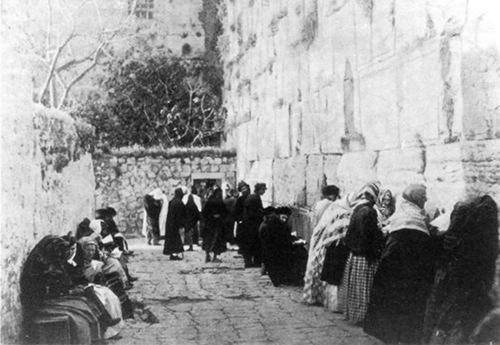
A section of western retaining wall left over from the Roman destruction of Herod's temple mount, which is today considered sacred by Jews. It once used to be called the Wailing Wall, because this was where the Jews used to gather each year on the 9th Av to remember the destruction of the temple, first by the Babylonians (6th Cent. BC) and then by the Romans (70 AD). It is called Hakotel ('the Wall') by Jews today. The part of the spacious plaza abutting the wall is today sectioned off as a synagogue, with the northern part reserved for men, and the southern part for women.
See Where ☰

The Western Wall viewed from the south.

Men at prayer at the Western Wall.
Until 1967 Jewish yearning for and access to the Wall was severely restricted; houses were built to within about four metres of the Wall. Religious expressions apart from prayers, such as the blowing of the shofar and the public reading of the Torah at the Wall was prohibited by the Muslims who controlled the Temple Mount, of which the Wall is a part.

The 'Wailing Wall' in an 1894 photograph taken by Robert Bain.
When Israeli soldiers took control of the area on 8 June during the 1967 War, the torrents of Jewish yearnings were irrupted. Within the next few days, bulldozers razed the area of the Muslim houses to create a plaza around the Wall; in the process more than a hundred Arabs lost were evicted (with only a few hours' notice). Today the site is a national monument, where Israelis and Jews from all over the world gather to pray, meditate, and to celebrate Bar-Mitzvas and birthdays. Jewish sentiments about the site was once neatly summed up by the former Chief Rabbi of the Ashkenazim, Rabbi Avraham Hacohen Kook:
The Temple Mount is Israel's eternal holy place, and even should it be under the hand of others for long days and periods of time, it will finally come to our hands . . . That we not enter within from [beyond] the Wall is not because of the slightness of our rights and the slightness of our connections to it. . . . The Western Wall, especially, was left to us as a remnant and a sign and as proof of our salvation and of the assurance of our return to the sacred standing-place [before God']. (Cited in M. Benvenisti, City of Stone. The Hidden History of Jerusalem)
Though religious Jews were at one time indifferent to the Zionist dream of re-establishing the Jewish nation, seeing it as God's responsibility, many religious Jews today—having tasted the power of political-military might their new nation now holds—are no longer content with just having the Western Wall to pray at. Instead, they boldly contemplate dangerous and violent thoughts (aided, sometimes quite openly, by Western extremist Christians) of destroying the Muslim institutions on the Temple Mount and rebuilding there a Third Temple.

A menorah created by the Temple Institute all ready for deployment in the 'Third Temple.'

©ALBERITH
190420lch